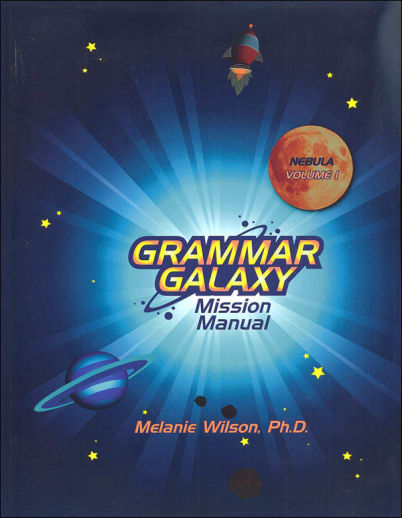Grammar Galaxy is a unique and engaging language arts program
for students in elementary, middle school, and even high school! Former
clinical psychologist Dr. Melanie Wilson cleverly disguises this language arts
program to recruit your students to save the Grammar Galaxy from the evil
Gremlin. The Gremlin is wreaking havoc around the galaxy. Helping verbs no
longer help! Idioms have become literal! Suffixes drop! The royal family needs
your help! If it sounds unconventional, then you have it right. This is not
your typical grammar course!
Each level has two components:
- The
Text is for the parent/teacher and includes the stories.
- The
Mission Manual is a consumable workbook for the student.
Students can start with Nebula and progress through the series
or enter at the appropriate grade levels. These grade suggestions are general
guidelines. Here is a link to the placement quiz from the publisher’s
website. You may also find the program’s Scope and Sequence helpful when determining
the correct entry level for your student.
- Nebula for
beginning communicators (2nd, possibly 1st)
- Protostar (3rd,
possibly 2nd)
- Yellow
Star (4th)
- Red
Star (5th)
- Blue
Star (6th)
- Nova (7th)
- Supernova (8th)
The lessons (excuse me, missions) in this curriculum start by reading aloud
the Text’s approximately 10-minute chapter mysteries (older
grade-level readers can do so independently, but with some parental
assistance). Next, the student completes short missions by writing or dictating
(for younger students) using the required Mission Manual (consumable
student worktext). Missions are grouped by topic, allowing a mastery-based
approach to English. Each mission follows a three-step process to complete
throughout the week or in a long class period. Vocabulary words are taken from
the story.
Step by step, students will read the chapter mission and then
solve missions using the Manual. As students complete tasks in this
imaginary galaxy, they will learn the nuts and bolts of language arts: literature,
vocabulary, spelling, grammar, composition, and speaking
(no phonics or handwriting instruction). While each of these topics is covered
yearly, subskills are taught with a mastery intent and will vary and build upon
previous years.
For example, the following topics are presented in these levels:
- Story
elements are introduced in Nebula (2nd)
- Pronouns
are introduced in Protostar (3rd)
- Pronoun-antecedents
are introduced in Yellow Star (4th)
- Foreshadowing
introduced in Red Star (5th)
- Diagramming
is introduced in Blue Star (6th)
Based on your student and your language arts goals, you may want
to annually add concept review and additional literature reading to strengthen
skills.
The Nova (7th) and Supernova
(8th) levels are designed as a grammar overview of all the previous
volumes. Older students without previous Grammar Galaxy experience may start
with the Nova level. Find extra course resources at www.FunToLearnBooks.com, like the author’s
blog and podcast.
For older students or those needing a harder challenge, look for
the Advanced
Guardian assignments. After each unit, including several missions each, students complete 10-question Challenge tests. Once these are passed, students can move on to the
next unit.
High school students needing a tidy grammar course with the fun
flair of Grammar Galaxy can look into Fast Grammar: High School Training Levels
1 and 2. The premise is that autocorrect is broken. It’s fast,
fictional, and fun!
~ Ruth/Sara


